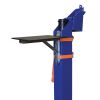Solinst Standalone Field Table
Features
- Legs are easily adjusted to different heights
- Easy to set up and can be deployed anywhere on your monitoring site
- Aluminum tabletop and frame will not rust
- Expedited repair and warranty service
- Lifetime technical support
- More
Overview
The Solinst Standalone Field Table from Solinst is made from lightweight aluminium (3.5 kg (7.7 lbs)). It features adjustable legs to meet height requirements. The legs can be easily set from 45 cm to 70 cm (17.7” to 27.6”) high. The tabletop and frame are simple to fold for transport and fit in a compact carry case with a handy shoulder strap. When folded and in the bag, the Field Table measures less than 96.5 cm x 20.3 cm x 14 cm (38" x 8" x 5.5").
Applications
The Standalone Field Table, with a larger tabletop surface area – 90.5 cm x 52 cm (35.6” x 20.5”) – is ideal for groundwater sampling applications. It provides a stable, level surface for equipment such as the Solinst Model 410 Peristaltic Pump or the 464 Electronic Pump Control Unit, as well as sample containers, coolers, etc. It also provides a space for disassembling equipment, such as pumps and bailers, for decontamination between sampling rounds.
- (1) Standalone field table
- (1) Carry bag
In The News
Save our Bogs! Culture, Conservation and Climate Action in Ireland’s Peatlands
Characterized by long-term accumulation under waterlogged conditions, peatlands exist on every continent and account for 3-4% of the global land surface . Small but mighty, these often overlooked wetland environments are estimated to hold as much as one-third of the world's organic carbon in their soil—twice the amount found in the entirety of the Earth's forest biomass. While healthy peatlands can trap and store carbon, regulate water, and provide important habitats for rare species, human alteration has disturbed peatland carbon and nitrogen cycles on a global scale. Approximately 12% of the world’s peatlands have been drained and degraded through conversion for agriculture, forestry, infrastructure development, and other uses.
Read MoreSargassum Surge: How Seaweed is Transforming our Oceans and Coastal Ecosystems
Until recently, Sargassum –a free-floating seaweed–was distributed throughout the Sargasso Sea , the north Caribbean Sea, and the Gulf of Mexico. But in the space of a decade, this seaweed has, as one scientist remarks , “Gone from a nonfactor to the source of a terrible crisis.” Driven by climate change, anomalous North Atlantic Oscillation in 2009-2010 and a glut of anthropogenic pollutants, sargassum has proliferated. Seasonally recurrent mats as deep as 7m now bloom in the “Great Atlantic Sargassum Belt” (GASB), which covers areas of the Atlantic from West Africa to the Caribbean Sea and Gulf of Mexico. Every year, millions of tons wash up along the shores of more than 30 countries . Dr.
Read MoreGreat Lakes Research Center: Designing Targeted Monitoring Solutions
According to the National Oceanic and Atmospheric Administration ( NOAA ), the Great Lakes have more miles of coastline than the contiguous Atlantic and Pacific coasts combined and contain 20 percent of the world's freshwater, making it a critical region to protect and conserve. Continuous monitoring and data-informed resource management are key components of managing waters in the region. Hayden Henderson, a research engineer with the Great Lakes Research Center (GLRC), designs and deploys monitoring platforms throughout the Great Lakes. With a background in environmental engineering, Henderson enjoyed the challenge of creating systems and making them work to obtain difficult, remote measurements.
Read More







